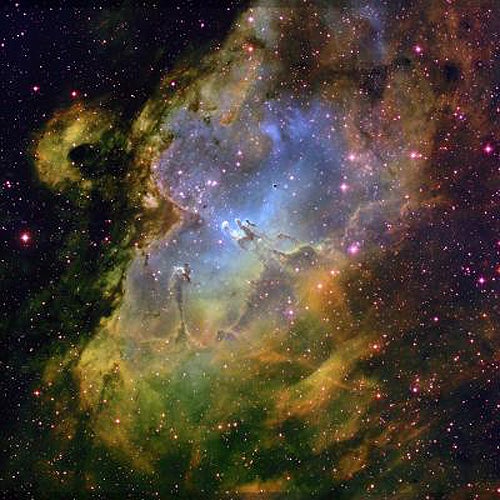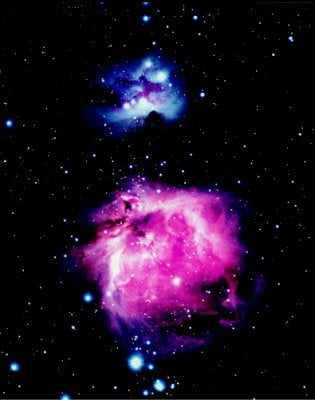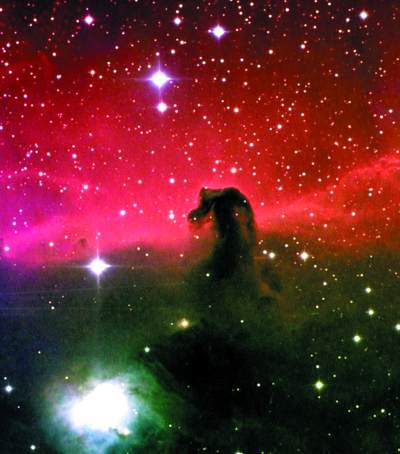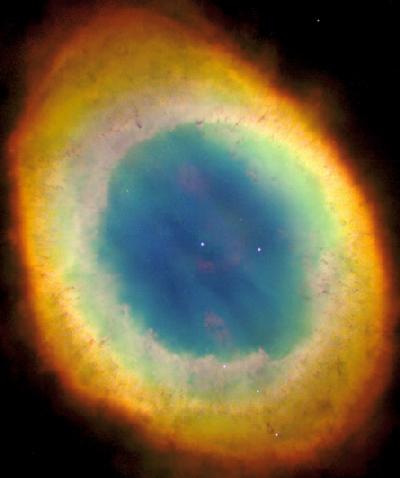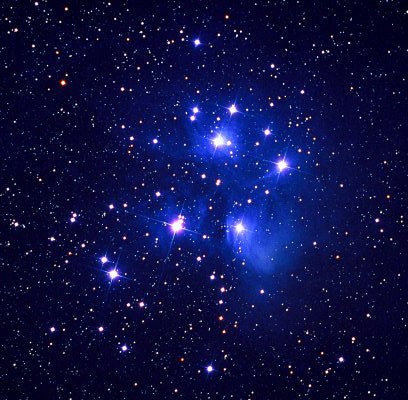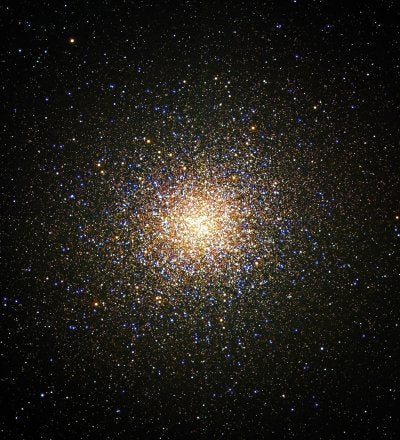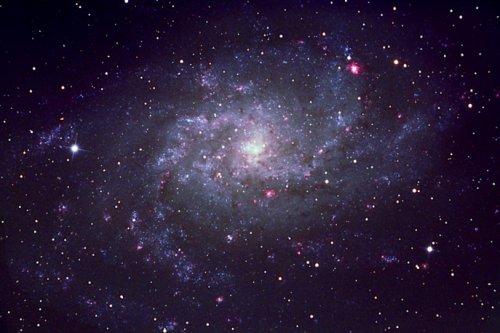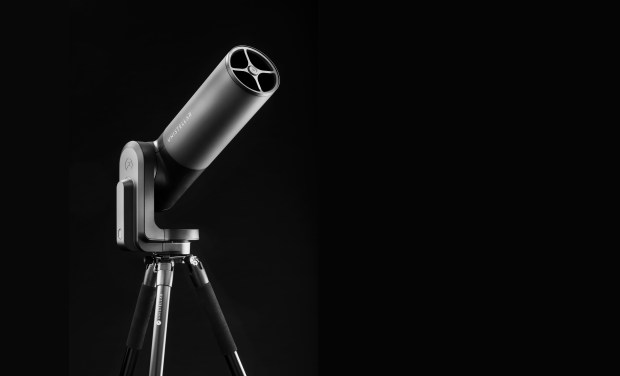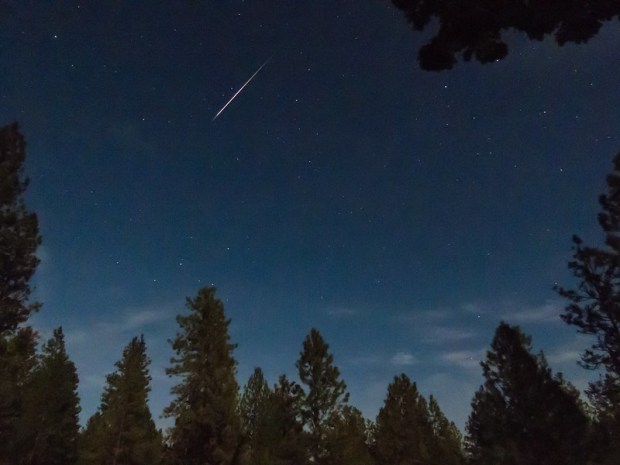Bright (or diffuse) nebulae are frequently places of star formation. When stars begin to form, the region becomes so hot that the stars’ radiation excites the gas of a nebula, causing it to shine. This type of bright nebula is known as an “emission nebula.” The process by which the gas (hydrogen) is excited is called “ionization.” Neutral, non-ionized hydrogen is designated HI. Ionized hydrogen is represented as HII. For this reason, emission nebulae often are referred to as HII regions.
If the stars are not hot enough to cause ionization of the surrounding gas, the starlight is reflected by the dust and can be seen as the second type of nebula — a “reflection nebula.” These nebulae look blue for the same reason our daytime sky appears blue — the light is being scattered throughout the nebula. A lot of nebulae have both emission and reflection components because some of the gas may be too far from the stars to be ionized by their radiation.
The first bright nebula discovered was the Orion Nebula (M42) in 1612. The first reflection nebula discovered was M78, also in Orion, in 1780. Other well-known, diffuse nebulae are M8, M16, M17, M20, and M43. M16 is actually a double object, a star cluster (NGC 6611) and a famous nebula known as the Eagle Nebula (IC 4703). M45, the Pleiades, also contains a reflection nebula.
| A list of the brightest nebulae | |||
|---|---|---|---|
| Catalog name | R.A. | Dec. | Size |
| NGC 281 | 00h53m | 56°36′ | 35′ by 30′ |
| IC 63 | 00h59m | 60°56′ | 10′ by 3′ |
| IC 1795 | 02h26m | 61°59′ | 12′ by 12′ |
| NGC 1432 | 03h46m | 24°09′ | 60′ by 40′ |
| NGC 1499 | 04h01m | 36°38′ | 160′ by 40′ |
| NGC 1491 | 04h03m | 51°19′ | 6′ by 9′ |
| NGC 1624 | 04h41m | 50°26′ | 5′ by 5′ |
| NGC 1788 | 05h06m | -03°21′ | 2′ by 2′ |
| NGC 1931 | 05h31m | 34°12′ | 4′ by 4′ |
| NGC 1952 | 05h35m | 22°02′ | 8′ by 4′ |
| IC 431 | 05h41m | -01°31′ | 8′ by 5′ |
| IC 432 | 05h42m | -01°34′ | 10′ by 10′ |
| IC 434 | 05h42m | -02°19′ | 90′ by 30′ |
| NGC 2023 | 05h42m | -02°19′ | 10′ by 8′ |
| NGC 1976 | 05h35m | -05°28′ | 90′ by 60′ |
| NGC 1999 | 05h36m | -06°44′ | 2′ by 2′ |
| NGC 2064 | 05h47m | 00°01′ | 10′ by 10′ |
| NGC 2170 | 06h07m | -06°23′ | 2′ by 2′ |
| NGC 2182 | 06h09m | -06°21′ | 3′ by 2′ |
| NGC 2175 | 06h10m | 20°29′ | 40′ by 30′ |
| NGC 2238 | 06h33m | 04°58′ | 80′ by 60′ |
| NGC 2245 | 06h33m | 10°10′ | 2′ by 2′ |
| NGC 2247 | 06h33m | 10°21′ | 2′ by 2′ |
| NGC 2261 | 06h39m | 08°43′ | 2′ by 1′ |
| NGC 2264 | 06h41m | 09°54′ | 10′ by 7′ |
| IC 2177 | 07h04m | -10°25′ | 20′ by 20′ |
| NGC 2467 | 07h52m | -26°28′ | 8′ by 7′ |
| IC 4606 | 16h29m | -26°37′ | 60′ by 40′ |
| NGC 6514 | 18h02m | -23°00′ | 20′ by 20′ |
| NGC 6523 | 18h04m | -24°20′ | 45′ by 30′ |
| NGC 6559 | 18h10m | -23°59′ | 15′ by 10′ |
| IC 1274 | 18h11m | -23°44′ | 20′ by 5′ |
| NGC 6590 | 18h17m | -19°44′ | 4′ by 3′ |
| NGC 6611 | 18h19m | -13°49′ | 120′ by 25′ |
| NGC 6618 | 18h21m | -15°59′ | 40′ by 30′ |
| NGC 6888 | 20h13m | 38°19′ | 20′ by 10′ |
| IC 1318A | 20h17m | 41°49′ | 45′ by 25′ |
| NGC 6914 | 20h25m | 42°19′ | 3′ by 3′ |
| IC 1318B | 20h28m | 40°00′ | 45′ by 20′ |
| IC 5067 | 20h51m | 44°21′ | 25′ by 10′ |
| IC 5076 | 20h56m | 47°24′ | 10′ by 10′ |
| NGC 7023 | 21h02m | 68°12′ | 10′ by 8′ |
| NGC 7129 | 21h42m | 66°04′ | 2′ by 2′ |
| NGC 7380 | 22h47m | 58°01′ | 25′ by 20′ |
| NGC 7538 | 23h14m | 61°29′ | 8′ by 7′ |
| NGC 7635 | 23h20m | 61°11′ | 15′ by 8′ |
Dark nebulae are clouds of dust and cold gas that can be seen because they obscure light from stars or bright nebulae behind them. The shapes of dark nebulae are among the strangest in the sky. Some dark nebulae, such as the Horsehead Nebula in Orion, are small and difficult to see even with large telescopes. Others, such as the Coal Sack in Crux, are large and easy to see with the naked eye.
The darkness of these objects is due to dust grains within the clouds and to the presence of extremely cold hydrogen molecules. The largest of the dark nebulae, called “molecular clouds,” are huge areas of star formation. The clouds must be cold or the radiation will heat up the individual atoms and prevent gravity from collecting them together. This would keep the gas from condensing into stars.
The first catalog of dark nebulae was prepared by American astronomer Edward Emerson Barnard (1857-1923). Use the following list to locate and observe the best of Barnard’s objects.
| Great objects from Barnard’s catalog | ||||
|---|---|---|---|---|
| Catalog name | Common name | R.A. | Dec. | Size |
| B33 | Horsehead | 05h41m | -02.5 | 6′ by 4′ |
| B42 | Rho Ophiuchi | 16h29m | -24.3 | 12′ by 12′ |
| B65/6/7 | Pipe (stem) | 17h21m | -26.8 | 300′ by 60′ |
| B72 | Snake | 17h24m | -23.6 | 30′ by 30′ |
| B78 | Pipe (bowl) | 17h33m | -25.7 | 200′ by 140′ |
| B86 | Ink Spot | 18h03m | -27.8 | 5′ by 3′ |
| B87 | Parrot’s Head | 18h04m | -32.7 | 12′ by 12′ |
| B142/3 | Barnard’s E | 19h41m | 11.0 | 110′ by 80′ |
| B348/9 | Cygnus Rift | 20h37m | 42.2 | 240′ by 240′ |
A planetary nebula is the most common end product of stellar evolution. Stars about as massive as the Sun eject mass when they become red giants near the end of their lives. After about 10,000 years (a short period, astronomically speaking), the inner core of the star collapses and the star pulsates, ejecting much of its outer envelope. This leaves a small star called a white dwarf. The ejected envelope becomes a spherical shell of cool, thin matter expanding into space at 5-25 miles/second (10-40 kilometers/second) — a planetary nebula.
The star (now called the central star of the nebula) is extremely hot, reaching temperatures of 200,000 Kelvin. It also emits a large amount of ultraviolet radiation. This radiation ionizes the gas of the expanding planetary nebula and causes it to glow. Planetary nebulae have short lives, at least visually. As the shell expands, the white dwarf’s energy can excite the gas, but only out to a certain distance. So after 10,000 to 50,000 years, the planetary nebula stops glowing. It’s still expanding, but we can no longer see it. Most astronomers agree that a planetary nebula is the fate of our Sun in approximately 5 billion years.
On July 12, 1764, French comet hunter Charles Messier (1730–1817) discovered the first planetary nebula and made it number 27 on his famous list of objects that are not comets. M27 also is known as the Dumbbell Nebula. It took 15 years before the next planetary nebula was discovered. The object was the now famous Ring Nebula (M57), and it was found in January 1779 by another French astronomer, Antoine Darquier (1718–1802), who compared it to a “fading planet.” The German-born, English astronomer William Herschel (1738–1822) christened these objects planetary nebulae because they resembled — in shape and color — Uranus, the planet he had discovered only a few years before.
There are roughly 1,000 known planetary nebula in our neighborhood of the galaxy. A typical planetary nebula is less than one light-year across. Planetary nebulae usually have a blue, green, bluish-green, or greenish-blue color. Observers often report different colors for the same nebula. What color will a particular planetary appear to you? This is a little tricky to answer. The problem is that the wavelength of the light is close to the border between perceived green color and perceived blue color. Thus, even a very slight shift in a person’s color response could cause the color to appear either greenish or bluish.
| Some of the finest planetary nebulae | |||
|---|---|---|---|
| Common name | Catalog name | R.A. | Dec. |
| Blinking Planetary | NGC 6826 | 19h45m | 50°32′ |
| Blue Snowball | NGC 7662 | 23h26m | 42°32′ |
| Box Nebula | NGC 6309 | 17h14m | -12°55′ |
| Bug Nebula | NGC 6302 | 17h14m | -37d06′ |
| Cat’s Eye Nebula | NGC 6543 | 17h59m | 66°38′ |
| Clown Face Nebula | NGC 2392 | 07h29m | 20°55′ |
| Crescent Nebula | NGC 6445 | 17h49m | -20°01′ |
| Dumbbell Nebula | NGC 6853 (M27) | 19h59m | 22°43′ |
| Eight Burst Nebula | NGC 3132 | 10h07m | -40°26′ |
| Eskimo Nebula | NGC 2392 | 07h29m | 20°55′ |
| Fetus Nebula | NGC 7008 | 21h01m | 54°33′ |
| Ghost of Jupiter | NGC 3242 | 10h25m | -18°39′ |
| Helix Nebula | NGC 7293 | 22h30m | -20°50′ |
| Little Dumbbell Nebula | NGC 650/651 (M76) | 01h42m | 51°35′ |
| Little Gem Nebula | NGC 6818 | 19h44m | -14°09′ |
| Owl Nebula | NGC 3587 (M97) | 11h15m | 55°01′ |
| Red Spider Nebula | NGC 6537 | 18h05m | -19°51′ |
| Ring Nebula | NGC 6720 (M57) | 18h54m | 33°02′ |
| Saturn Nebula | NGC 7009 | 21h04m | -11°22′ |
| Southern Ring Nebula | NGC 3132 | 10h07m | -40°26′ |
A star cluster is a group of stars loosely held together by gravity. There are three types of star clusters: associations, open clusters and globular clusters. Associations contain dozens of stars and resemble open clusters except that they are poorer in stars. Here, we’ll concentrate on the two other types of star clusters.
Open clusters. Located within the disk of the Milky Way Galaxy, open clusters also are known as “galactic clusters.” The Beehive (M44), the Pleiades (M45), and the Hyades clusters have numerous historical references. In the second century, Ptolemy mentioned Melotte 111 in Coma Berenices and M7 in Scorpius. Not until Galileo (1564-1642) trained his telescope on the Beehive, however, was it discovered that these objects are made of individual stars.
Sparse open clusters contain less than a hundred stars, while rich ones may have thousands. Open clusters form from nebulae. All open clusters are relatively young objects, generally no more than a few hundred million years old. We know the open clusters we observe are young because given enough time, the stars in an open cluster disperse due to gravitational interaction within the cluster. If we were able to follow a single open cluster from its formation, we would see the cluster disperse stars throughout its entire galactic journey. Approximately 1,700 open clusters are known.
Open clusters are pretty. This makes them fun to look at for beginning amateur astronomers. But many advanced amateurs spend a great deal of time observing open clusters as well. Compared with other deep-sky objects, open clusters are relatively large. This means you will generally be using low-power eyepieces, which provide wide fields of view. Some clusters are large enough and bright enough that binoculars will provide more satisfying views.
Take your time when observing an open cluster. Examine the field of view closely. Try to discern the members of the cluster as opposed to stars that only appear in the field of view. This is easy in many cases, but it can be a real trick when the cluster lies within the area of the Milky Way. Also, large telescopes sometimes can hinder the identification of cluster stars, causing confusion by making so many background stars visible.
| Fifty bright open clusters | ||
|---|---|---|
| Catalog name | Constellation | Magnitude |
| M45 | Taurus | 1.6 |
| M7 | Scorpius | 3.3 |
| M44 | Cancer | 3.9 |
| NGC 869/884 | Perseus | 4.4 |
| NGC 2244 | Monoceros | 4.8 |
| NGC 2362 | Canis Major | 4.8 |
| M41 | Canis Major | 5.0 |
| M47 | Puppis | 5.0 |
| M39 | Cygnus | 5.3 |
| NGC 2244 | Monoceros | 5.3 |
| NGC 6633 | Ophiuchus | 5.3 |
| M6 | Scorpius | 5.5 |
| M35 | Gemini | 5.6 |
| NGC 7686 | Cassiopeia | 5.6 |
| M34 | Perseus | 5.8 |
| M23 | Sagittarius | 5.9 |
| M48 | Hydra | 6.0 |
| NGC 1647 | Taurus | 6.0 |
| NGC 1746 | Taurus | 6.0 |
| NGC 1981 | Orion | 6.0 |
| NGC 2264 | Monoceros | 6.0 |
| NGC 2301 | Monoceros | 6.0 |
| M67 | Cancer | 6.1 |
| NGC 7160 | Cepheus | 6.1 |
| M25 | Sagittarius | 6.2 |
| M37 | Auriga | 6.2 |
| NGC 1545 | Perseus | 6.2 |
| M50 | Monoceros | 6.3 |
| NGC 6940 | Vulpecula | 6.3 |
| NGC 457 | Cassiopeia | 6.4 |
| NGC 7243 | Lacerta | 6.4 |
| M21 | Sagittarius | 6.5 |
| M36 | Auriga | 6.5 |
| M93 | Puppis | 6.5 |
| NGC 129 | Cassiopeia | 6.5 |
| NGC 654 | Cassiopeia | 6.5 |
| NGC 752 | Andromeda | 6.5 |
| NGC 663 | Cassiopeia | 6.5 |
| NGC 1528 | Perseus | 6.5 |
| M16 | Serpens | 6.6 |
| M46 | Puppis | 6.6 |
| NGC 1027 | Cassiopeia | 6.7 |
| NGC 2343 | Monoceros | 6.7 |
| NGC 2423 | Puppis | 6.7 |
| NGC 7209 | Lacerta | 6.7 |
| NGC 7789 | Cassiopeia | 6.7 |
| M11 | Scutum | 6.8 |
| NGC 7036 | Cygnus | 6.8 |
| M103 | Cassiopeia | 6.9 |
| M38 | Auriga | 7.0 |
The other main cluster type is a globular cluster. These objects are spherical in shape and the greatest concentration of stars lies toward their centers. Globular clusters have many more stars than open clusters, ranging from about ten thousand stars to more than one million stars. Globular clusters are old. Most are in excess of 10 billion years old.
What really sets globulars apart, however, isn’t their age, but their location. Open clusters lie within the spiral arms (disk) of our Milky Way Galaxy. Globular clusters surround the Milky Way in a spherical distribution. This structure is often called the “halo.” Studying the distribution of globular clusters around the Scorpius-Sagittarius area correctly led Harlow Shapley (1885–1972) to conclude that the center of our galaxy must lie in that direction.
M22, a beautiful object in Sagittarius, was the first globular cluster to be discovered, in 1665. Twelve years later, the great southern globular Omega Centauri was observed by Edmund Halley (1656–1742). Today, about 200 globular clusters are known to surround our galaxy. Globulars have been observed around many other galaxies as well. As an example, the giant elliptical galaxy M87 in Virgo contains more than one thousand globular clusters.
In the entire deep-sky menagerie, no group excites new observers more than globular clusters. Even seasoned amateur astronomers consider globulars to be the most rewarding objects to observe. It’s easy to see why. Many are bright enough to be seen even from urban settings. But when observed from a dark site, these objects explode with detail. The use of higher magnifications brings whole new levels of detail to these clusters. Faint fuzz resolves itself into individual sparkling points of light that form intricate patterns.
| The 25 brightest globular clusters | |||
|---|---|---|---|
| Catalog name | Common name | Constellation | Magnitude |
| NGC 5139 | Omega Centauri | Centaurus | 3.9 |
| NGC 104 | 47 Tuc | Tucana | 4.0 |
| NGC 6656 | M22 | Sagittarius | 5.2 |
| NGC 6397 | Ara | 5.3 | |
| NGC 6752 | Pavo | 5.3 | |
| NGC 6121 | M4 | Scorpius | 5.4 |
| NGC 5904 | M5 | Serpens | 5.4 |
| NGC 6205 | M13 | Hercules | 5.8 |
| NGC 6218 | M12 | Ophiuchus | 6.1 |
| NGC 2808 | Carina | 6.2 | |
| NGC 6809 | M55 | Sagittarius | 6.3 |
| NGC 6541 | Corona Australis | 6.3 | |
| NGC 5272 | M3 | Canes Venatici | 6.3 |
| NGC 7078 | M15 | Pegasus | 6.3 |
| NGC 6266 | M62 | Ophiuchus | 6.4 |
| NGC 6341 | M92 | Hercules | 6.5 |
| NGC 6254 | M10 | Ophiuchus | 6.6 |
| NGC 7089 | M2 | Aquarius | 6.6 |
| NGC 362 | Tucana | 6.8 | |
| NGC 6723 | Sagittarius | 6.8 | |
| NGC 6388 | Scorpius | 6.8 | |
| NGC 6723 | M19 | Ophiuchus | 6.8 |
| NGC 7099 | M30 | Capricornus | 6.9 |
| NGC 3201 | Vela | 6.9 | |
| NGC 6626 | M28 | Sagittarius | 6.9 |
You might wonder how objects composed of up to a trillion or more individual stars could be so difficult to observe. Of course, the answer is distance. Galaxies are so far away that, except for a small number, they all appear small and faint. Even advanced observers regard observing faint galaxies as a challenge.
Today, we are indebted to the great American astronomer Edwin Hubble (1889–1953) for developing a simple classification scheme for galaxies. Hubble first mentioned this in a paper he wrote in 1922. Four years later, he expanded it and added some illustrations. Finally, in 1936, Hubble provided a better explanation of the classification scheme in his book The Realm of the Nebulae. And it was in this book that the famous “tuning fork” diagram first appeared.
Hubble’s scheme described several different main types of galaxies: ellipticals, spirals, and barred spirals. That’s three. An argument for a fourth Hubble type (off the tuning fork) could be made. The fourth class contains “irregular galaxies,” essentially every galaxy not on the fork.
After stars form, they arrange themselves into clusters. So do galaxies. Clusters of galaxies may be made up of a handful of galaxies or as many as a thousand. As with star clusters, clusters of galaxies are held together by mutual gravitational attraction. Please note that a galactic cluster and a cluster of galaxies are totally different. The first is a group of stars (also known as an open cluster). The second is a group of galaxies. The most famous cluster of galaxies is the one that contains our Milky Way. Known as the Local Group, it is composed of almost 40 members.
Two other well-known and well-observed clusters of galaxies are the Virgo cluster and the Fornax cluster. The Virgo cluster lies nearly 50 million light-years from Earth and is a bright cluster. A number of Messier objects are members of it, including M49, M49, M60, M84, M85, M86, M87, M88, M89, M90, M98, M99, and M100. In addition, more than one hundred NGC galaxies belong to the Virgo cluster.
Many observers think the Fornax cluster is the finest for amateur astronomers to observe. Eighteen galaxies make up the cluster. The brightest is NGC 1316 at visual magnitude 8.8. NGC 1399, magnitude 9.8, is the next easiest to see. NGC 1365 is third at magnitude 9.5. This galaxy is a barred spiral seen face on, with open spiral arms. In a wide-field, high-power eyepiece, up to ten members of this cluster of galaxies can be viewed.
The largest separate structures in the universe, and some would say the structures that define the shape of our universe, are superclusters of galaxies. The Local Group, which contains the Milky Way, belongs to a supercluster of galaxies called the Local Supercluster. The Local Group is at one end and the Virgo cluster is near its center. The major axis of the Local Supercluster stretches 125 to 150 million light-years. Other nearby superclusters of galaxies include the Hydra-Centaurus Supercluster, which lies at a distance of about 150 million light-years and the Perseus Supercluster, which is roughly 220 million light-years away.
| Galaxies brighter than 10th magnitude | |||
|---|---|---|---|
| Catalog name | R.A. | Dec. | Magnitude |
| LMC | 05h24m | -69°45′ | 0.91 |
| SMC | 00h53m | -72°48′ | 2.70 |
| NGC 224 | 00h43m | 41°16′ | 4.36 |
| NGC 598 | 01h34m | 30°40′ | 6.27 |
| NGC 5128 | 13h25m | -43°01′ | 7.84 |
| NGC 3031 | 09h56m | 69°04′ | 7.89 |
| NGC 253 | 00h48m | -25°17′ | 8.04 |
| NGC 5236 | 13h37m | -29°52′ | 8.20 |
| NGC 5457 | 14h03m | 54°21′ | 8.31 |
| Fornax | 02h40m | -34°27′ | 8.40 |
| NGC 55 | 00h15m | -39°13′ | 8.42 |
| NGC 300 | 00h55m | -37°41′ | 8.72 |
| NGC 205 | 00h40m | 41°41′ | 8.92 |
| NGC 2403 | 07h37m | 65°36′ | 8.93 |
| NGC 5194 | 13h30m | 47°12′ | 8.96 |
| NGC 4594 | 12h40m | -11°37′ | 8.98 |
| NGC 4736 | 12h51m | 41°07′ | 8.99 |
| NGC 221 | 00h43m | 40°52′ | 9.03 |
| IC 342 | 03h47m | 68°06′ | 9.10 |
| NGC 4258 | 12h19m | 47°18′ | 9.10 |
| NGC 6744 | 19h10m | -63°51′ | 9.14 |
| NGC 1313 | 03h18m | -66°30′ | 9.20 |
| NGC 3034 | 09h56m | 69°41′ | 9.30 |
| NGC 4945 | 13h05m | -49°28′ | 9.30 |
| NGC 5055 | 13h16m | 42°02′ | 9.31 |
| NGC 6822 | 19h45m | -14°48′ | 9.31 |
| NGC 4826 | 12h57m | 21°41′ | 9.36 |
| NGC 4472 | 12h30m | 07°59′ | 9.37 |
| NGC 1291 | 03h17m | -41°06′ | 9.39 |
| NGC 1316 | 03h23m | -37°12′ | 9.42 |
| Sculptor | 01h00m | -33°43′ | 9.50 |
| NGC 4486 | 12h31m | 12°23′ | 9.59 |
| NGC 1068 | 02h43m | -00°01′ | 9.61 |
| NGC 6946 | 20h35m | 60°09′ | 9.61 |
| NGC 7793 | 23h58m | -32°35′ | 9.63 |
| NGC 3627 | 11h20m | 12°59′ | 9.65 |
| NGC 247 | 00h47m | -20°46′ | 9.67 |
| NGC 2903 | 09h32m | 21°30′ | 9.68 |
| NGC 4631 | 12h42m | 32°32′ | 9.75 |
| NGC 4649 | 12h44m | 11°33′ | 9.81 |
| NGC 3521 | 11h06m | -00°02′ | 9.83 |
| NGC 4406 | 12h26m | 12°57′ | 9.83 |
| NGC 3115 | 10h05m | -07°43′ | 9.87 |
| IC 1613 | 01h05m | 02°07′ | 9.88 |
| NGC 628 | 01h37m | 15°47′ | 9.95 |
| NGC 4449 | 12h28m | 44°06′ | 9.99 |
- Video: How to use a star chart — Senior Editor Rich Talcott helps you navigate the night sky using Astronomy magazine’s pullout star chart, located in the center of each monthly issue.
- StarDome — Astronomy.com’s interactive star chart lets you construct an accurate map of your sky and find your favorite constellations, planets, galaxies, and more. [Related video: How to use Astronomy.com’s interactive star chart StarDome]
- ABCs of observing — Sharpen your scope skills with these 26 tips
- Constellation observing — Downloadable articles that highlight all 88 constellations in the sky and explain how to observe each constellation’s deep-sky targets.
- Weekly observing podcast highlights three objects you can see in the night sky

